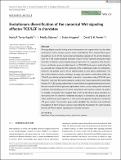Evolutionary diversification of the canonical Wnt signaling effector TCF/LEF in chordates
Abstract
Wnt signaling is essential during animal development and regeneration, but also plays an important role in diseases such as cancer and diabetes. The canonical Wnt signaling pathway is one of the most conserved signaling cascades in the animal kingdom, with the T-cell factor/lymphoid enhancer factor (TCF/LEF) proteins the major mediators of Wnt/β-catenin-regulated gene expression. In comparison to invertebrates, vertebrates possess a high diversity of TCF/LEF family genes, implicating this as a possible key change to Wnt signaling at the evolutionary origin of vertebrates. However, the precise nature of this diversification is only poorly understood. The aim of this study is to clarify orthology, paralogy and isoform relationships within the TCF/LEF gene family within chordates via in silico comparative study of TCF/LEF gene structure, molecular phylogeny and gene synteny. Our results support the notion that the four TCF/LEF paralog subfamilies in jawed vertebrates (gnathostomes) evolved via the two rounds of whole-genome duplication that occurred during early vertebrate evolution. Importantly, gene structure comparisons and synteny analysis of jawless vertebrate (cyclostome) TCFs suggest that a TCF7L2-like form of gene structure is a close proxy for the ancestral vertebrate structure. In conclusion, we propose a detailed evolutionary path based on a new pre-whole-genome duplication vertebrate TCF gene model. This ancestor gene model highlights the chordate and vertebrate innovations of TCF/LEF gene structure, providing the foundation for understanding the role of Wnt/β-catenin signaling in vertebrate evolution.
Citation
Torres-Aguila , N P , Salonna , M , Hoppler , S & Ferrier , D E K 2022 , ' Evolutionary diversification of the canonical Wnt signaling effector TCF/LEF in chordates ' , Development, Growth & Differentiation , vol. 64 , no. 3 , pp. 120-137 . https://doi.org/10.1111/dgd.12771
Publication
Development, Growth & Differentiation
Status
Peer reviewed
ISSN
0012-1592Type
Journal article
Description
This work was supported by the Biotechnology and Biological Sciences Research Council (BBSRC), linked projects, references BB/S016856/1 and BB/S020640/1.Collections
Items in the St Andrews Research Repository are protected by copyright, with all rights reserved, unless otherwise indicated.

